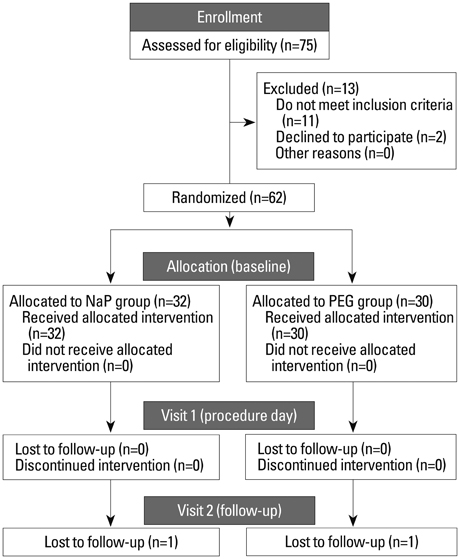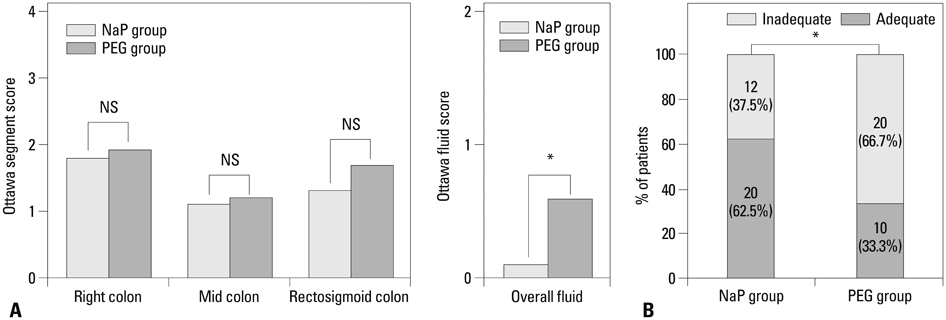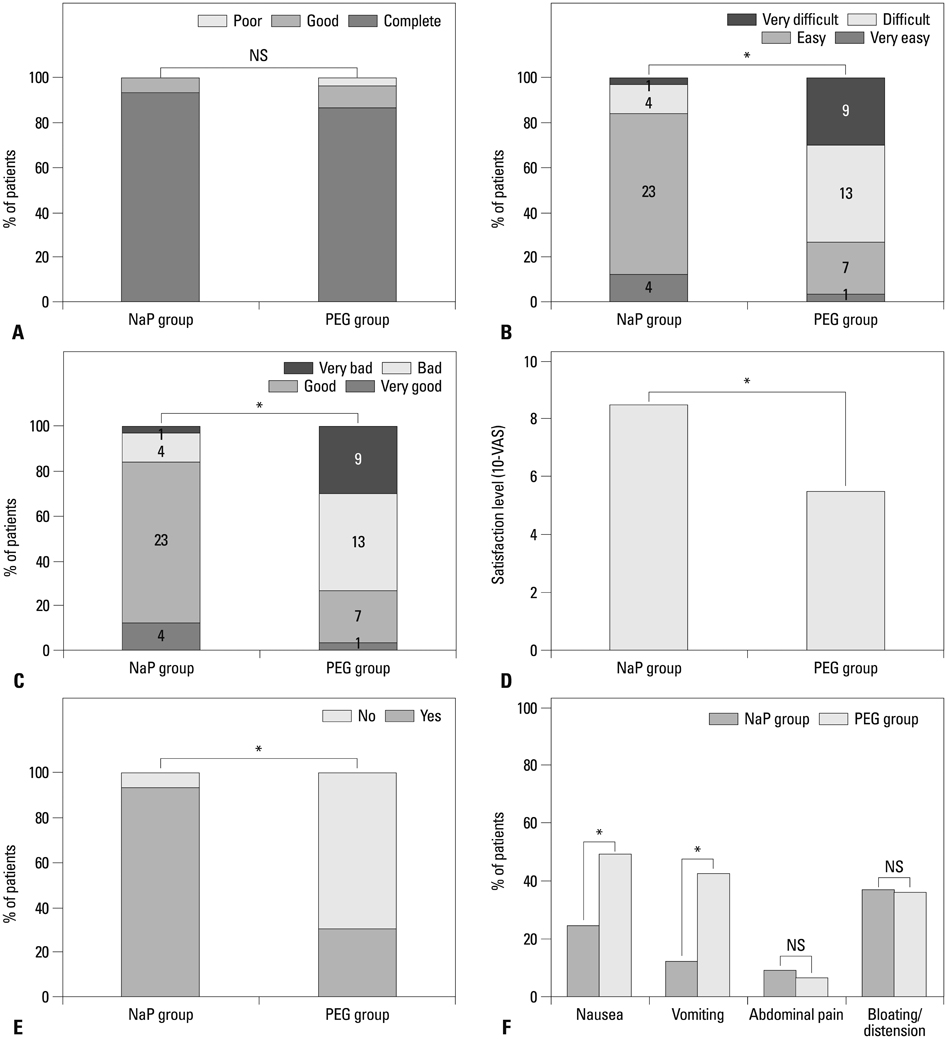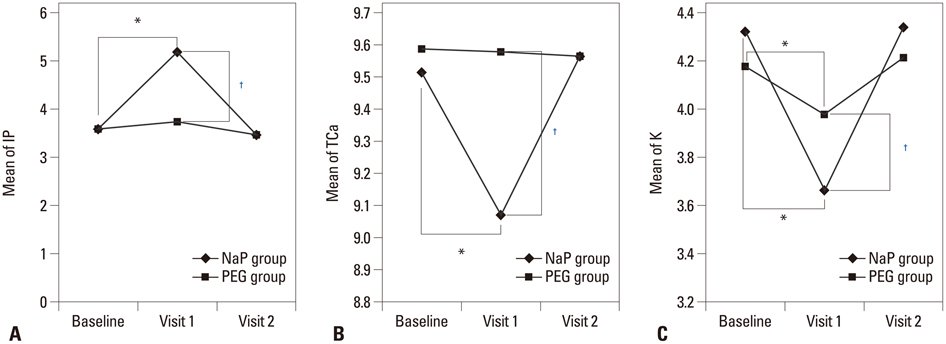Yonsei Med J.
2014 Nov;55(6):1542-1555. 10.3349/ymj.2014.55.6.1542.
Comparison of the Efficacy and Safety of Sodium Phosphate Tablets and Polyethylene Glycol Solution for Bowel Cleansing in Healthy Korean Adults
- Affiliations
-
- 1Health Promotion Center, Ajou University School of Medicine, Suwon, Korea. djleemd@medicus.co.kr
- 2Department of Gastroenterology, Ajou University School of Medicine, Suwon, Korea.
- 3Department of Anesthesiology, Seoul National University College of Medicine, Seoul, Korea.
- 4Health Promotion Center, Wonkwang University College of Medicine, Gunpo, Korea.
- KMID: 2070201
- DOI: http://doi.org/10.3349/ymj.2014.55.6.1542
Abstract
- PURPOSE
Bowel cleansing is generally regarded as time-consuming and unpleasant among patients. Patients commonly state that bowel preparation provokes more discomfort than the actual colonoscopic examination. The purpose of this study was to compare two regimens of sodium phosphate (NaP) tablets versus polyethylene glycol (PEG) solution for bowel preparation in healthy Korean adults.
MATERIALS AND METHODS
This was a single center, prospective, open-label, investigator-blinded, randomized, controlled-pilot study. A total of 62 healthy Korean subjects were randomly assigned to two groups (NaP vs. PEG). Efficacy, safety, and patient-related outcomes, as well as procedural parameters, were evaluated.
RESULTS
Although there were no significant differences in total Ottawa bowel quality score, fluid scores and the rate of adequate bowel preparation were significantly better in the NaP group than the PEG group. Additionally, the NaP group showed better results regarding patient tolerance, satisfaction, preference, and rate of adverse events than the PEG group. Significant fluctuations in specific serum electrolytes were common and of a greater magnitude in the NaP group than the PEG group. However, these abnormalities were transient and did not result in serious complications and side effects.
CONCLUSION
In this study, NaP tablets were shown to be an effective, well-tolerated, and acceptable regimen for bowel preparation. Also, our study suggests that NaP tablets may be safe and can be used as a bowel cleansing agent in healthy adults undergoing elective colonoscopy. Further multicenter, large scale studies are needed to confirm these findings.
MeSH Terms
-
Adult
Asian Continental Ancestry Group
*Colonoscopy
Female
Humans
Male
Middle Aged
Phosphates/*administration & dosage/therapeutic use
Pilot Projects
Polyethylene Glycols/*administration & dosage/therapeutic use
Prospective Studies
Republic of Korea
Surface-Active Agents/*administration & dosage
Tablets
Therapeutic Irrigation/*methods
Phosphates
Polyethylene Glycols
Surface-Active Agents
Tablets
Figure
Reference
-
1. Chung SH, Park SJ, Cheon JH, Park MS, Hong SP, Kim TI, et al. Factors predictive of high-risk adenomas at the third colonoscopy after initial adenoma removal. J Korean Med Sci. 2013; 28:1345–1350.
Article2. Ko HJ, Youn CH. Determination of the beginning age for colonoscopic screening among colonoscopy-naïve individuals. Clin Res Hepatol Gastroenterol. 2012; 36:384–390.
Article3. Kim YJ. What is a Reasonable Screening Test for Colorectal Cancer. J Korean Soc Coloproctol. 2010; 26:375.
Article4. Choi Y, Choi HS, Jeon WK, Kim BI, Park DI, Cho YK, et al. Optimal number of endoscopic biopsies in diagnosis of advanced gastric and colorectal cancer. J Korean Med Sci. 2012; 27:36–39.
Article5. Rees CJ, Rajasekhar PT, Rutter MD, Dekker E. Quality in colonoscopy: European perspectives and practice. Expert Rev Gastroenterol Hepatol. 2014; 8:29–47.
Article6. Winawer S, Fletcher R, Rex D, Bond J, Burt R, Ferrucci J, et al. Colorectal cancer screening and surveillance: clinical guidelines and rationale-Update based on new evidence. Gastroenterology. 2003; 124:544–560.
Article7. Komeda Y, Suzuki N, Sarah M, Thomas-Gibson S, Vance M, Fraser C, et al. Factors associated with failed polyp retrieval at screening colonoscopy. Gastrointest Endosc. 2013; 77:395–400.
Article8. Lee TJ, Rutter MD, Blanks RG, Moss SM, Goddard AF, Chilton A, et al. Colonoscopy quality measures: experience from the NHS Bowel Cancer Screening Programme. Gut. 2012; 61:1050–1057.
Article9. Gavin DR, Valori RM, Anderson JT, Donnelly MT, Williams JG, Swarbrick ET. The national colonoscopy audit: a nationwide assessment of the quality and safety of colonoscopy in the UK. Gut. 2013; 62:242–249.
Article10. Chiu HM, Lin JT, Wang HP, Lee YC, Wu MS. The impact of colon preparation timing on colonoscopic detection of colorectal neoplasms--a prospective endoscopist-blinded randomized trial. Am J Gastroenterol. 2006; 101:2719–2725.
Article11. Froehlich F, Wietlisbach V, Gonvers JJ, Burnand B, Vader JP. Impact of colonic cleansing on quality and diagnostic yield of colonoscopy: the European Panel of Appropriateness of Gastrointestinal Endoscopy European multicenter study. Gastrointest Endosc. 2005; 61:378–384.
Article12. Adler A, Wegscheider K, Lieberman D, Aminalai A, Aschenbeck J, Drossel R, et al. Factors determining the quality of screening colonoscopy: a prospective study on adenoma detection rates, from 12,134 examinations (Berlin colonoscopy project 3, BECOP-3). Gut. 2013; 62:236–241.
Article13. Lee RH. Quality colonoscopy: a matter of time, technique or technology? World J Gastroenterol. 2013; 19:1517–1522.
Article14. Rex DK, Petrini JL, Baron TH, Chak A, Cohen J, Deal SE, et al. Quality indicators for colonoscopy. Am J Gastroenterol. 2006; 101:873–885.
Article15. Moon W. Optimal and safe bowel preparation for colonoscopy. Clin Endosc. 2013; 46:219–223.
Article16. Poon CM, Lee DW, Mak SK, Ko CW, Chan KC, Chan KW, et al. Two liters of polyethylene glycol-electrolyte lavage solution versus sodium phosphate as bowel cleansing regimen for colonoscopy: a prospective randomized controlled trial. Endoscopy. 2002; 34:560–563.
Article17. Hosoe N, Nakashita M, Imaeda H, Sujino T, Bessho R, Ichikawa R, et al. Comparison of patient acceptance of sodium phosphate versus polyethylene glycol plus sodium picosulfate for colon cleansing in Japanese. J Gastroenterol Hepatol. 2012; 27:1617–1622.
Article18. Malik P, Balaban DH, Thompson WO, Galt DJ. Randomized study comparing two regimens of oral sodium phosphates solution versus low-dose polyethylene glycol and bisacodyl. Dig Dis Sci. 2009; 54:833–841.
Article19. Pereyra L, Cimmino D, González Malla C, Laporte M, Rotholtz N, Peczan C, et al. Colonic preparation before colonoscopy in constipated and non-constipated patients: a randomized study. World J Gastroenterol. 2013; 19:5103–5110.
Article20. De Silva AP, Kumarasena RS, Perera Keragala SD, Kalubowila U, Niriella M, Dassanayake AS, et al. The prone 12 o'clock position reduces ileal intubation time during colonoscopy compared to the left lateral 6 o'clock (standard) position. BMC Gastroenterol. 2011; 11:89.
Article21. Powell N, Hayee BH, Yeoh DP, Rowbotham DS, Saxena V, McNair A. Terminal ileal photography or biopsy to verify total colonoscopy: does the endoscope agree with the microscope? Gastrointest Endosc. 2007; 66:320–325.
Article22. Rostom A, Jolicoeur E. Validation of a new scale for the assessment of bowel preparation quality. Gastrointest Endosc. 2004; 59:482–486.
Article23. Rostom A, Jolicoeur E, Dubé C, Grégoire S, Patel D, Saloojee N, et al. A randomized prospective trial comparing different regimens of oral sodium phosphate and polyethylene glycol-based lavage solution in the preparation of patients for colonoscopy. Gastrointest Endosc. 2006; 64:544–552.
Article24. Brahmania M, Ou G, Bressler B, Ko HK, Lam E, Telford J, et al. 2 L versus 4 L of PEG3350 + electrolytes for outpatient colonic preparation: a randomized, controlled trial. Gastrointest Endosc. 2014; 79:408–416.
Article25. Bae SE, Kim KJ, Eum JB, Yang DH, Ye BD, Byeon JS, et al. A comparison of 2 L of polyethylene glycol and 45 mL of sodium phosphate versus 4 L of polyethylene glycol for bowel cleansing: a prospective randomized trial. Gut Liver. 2013; 7:423–429.
Article26. Kambe H, Yamaji Y, Sugimoto T, Yamada A, Watabe H, Yoshida H, et al. A randomized controlled trial of sodium phosphate tablets and polyethylene glycol solution for polyp detection. J Dig Dis. 2012; 13:374–380.
Article27. Aihara H, Saito S, Arakawa H, Imazu H, Omar S, Kaise M, et al. Comparison of two sodium phosphate tablet-based regimens and a polyethylene glycol regimen for colon cleansing prior to colonoscopy: a randomized prospective pilot study. Int J Colorectal Dis. 2009; 24:1023–1030.
Article28. Kastenberg D, Chasen R, Choudhary C, Riff D, Steinberg S, Weiss E, et al. Efficacy and safety of sodium phosphate tablets compared with PEG solution in colon cleansing: two identically designed, randomized, controlled, parallel group, multicenter phase III trials. Gastrointest Endosc. 2001; 54:705–713.
Article29. van Vugt van Pinxteren MW, van Kouwen MC, van Oijen MG, van Achterberg T, Nagengast FM. A prospective study of bowel preparation for colonoscopy with polyethylene glycol-electrolyte solution versus sodium phosphate in Lynch syndrome: a randomized trial. Fam Cancer. 2012; 11:337–341.
Article30. Juluri R, Eckert G, Imperiale TF. Polyethylene glycol vs. sodium phosphate for bowel preparation: a treatment arm meta-analysis of randomized controlled trials. BMC Gastroenterol. 2011; 11:38.
Article31. Johanson JF, Popp JW Jr, Cohen LB, Lottes SR, Forbes WP, Walker K, et al. A randomized, multicenter study comparing the safety and efficacy of sodium phosphate tablets with 2L polyethylene glycol solution plus bisacodyl tablets for colon cleansing. Am J Gastroenterol. 2007; 102:2238–2246.
Article32. Vanner SJ, MacDonald PH, Paterson WG, Prentice RS, Da Costa LR, Beck IT. A randomized prospective trial comparing oral sodium phosphate with standard polyethylene glycol-based lavage solution (Golytely) in the preparation of patients for colonoscopy. Am J Gastroenterol. 1990; 85:422–427.33. Kan WC, Wang HY, Chien CC, Tan CK, Lin CY, Su SB. Intermediate bioelectrolyte changes after phospho-soda or polyethylene glycol precolonoscopic laxatives in a population undergoing health examinations. Nephrol Dial Transplant. 2012; 27:752–757.
Article34. Cohen SM, Wexner SD, Binderow SR, Nogueras JJ, Daniel N, Ehrenpreis ED, et al. Prospective, randomized, endoscopic-blinded trial comparing precolonoscopy bowel cleansing methods. Dis Colon Rectum. 1994; 37:689–696.
Article35. Hookey LC, Depew WT, Vanner S. The safety profile of oral sodium phosphate for colonic cleansing before colonoscopy in adults. Gastrointest Endosc. 2002; 56:895–902.
Article
- Full Text Links
- Actions
-
Cited
- CITED
-
- Close
- Share
- Similar articles
-
- A Comparison of Oral Sodium Phosphate and Polyethylene Glycol Solution for
- A Prospective Comparison of Sulfate Free Polyethylene Glycol versus Sodium Phosphate Solution for Precolonoscopic Bowel Preparation
- A Randomized Prospective Trial Comparing a New Polyethylene Glycol Based Lavage Solution with the Standard Polyethylene Glycol Solution in the Preparation of Patients Undergoing Colonoscopy (Clinical trial of new PEG solution in bowel preparation)
- Optimal and Safe Bowel Preparation for Colonoscopy
- A Comparison of Fleet(R) with Colonlyte(R) for Precolonoscopic Preparation





